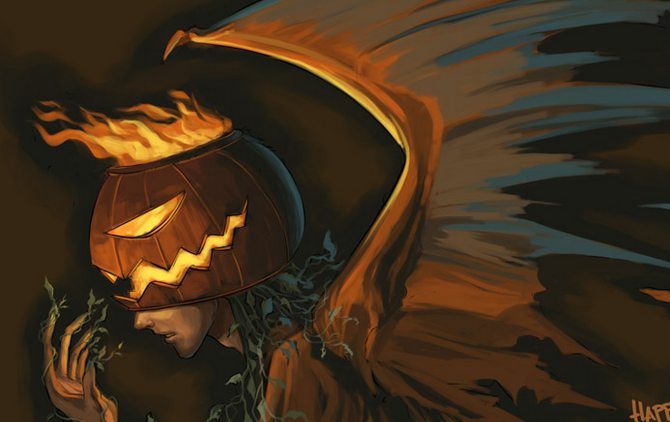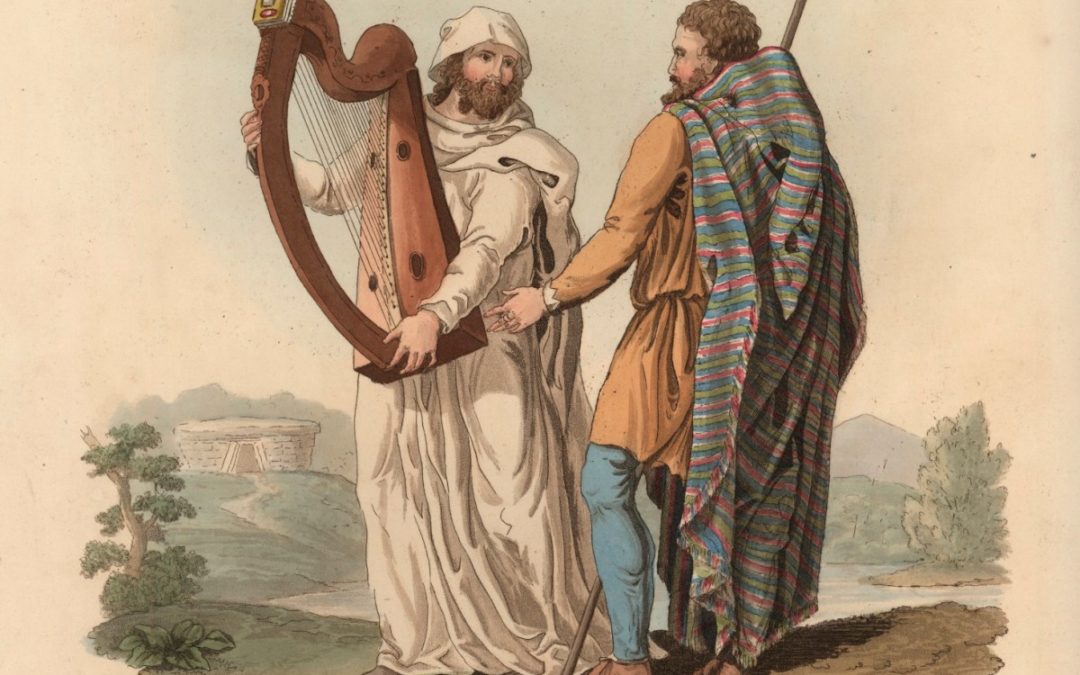
by Moe | Oct 13, 2019 | History of the Brotherhood, Irish History, Latest Media
oIt is the unanimous testimony of almost all Irish Historians, that the Tuath-de-Danaans (Tribe of Dan) were learned, and well skilled in Science and Magic. For many hundreds of years thereafter, Ireland became celebrated as the main center for learning and the export and import of a group of wise men known in the Old Gaelic language as the Ollam (Ollamh, Ollave, Olaf) and to their Brethren of the East, the Ulam.
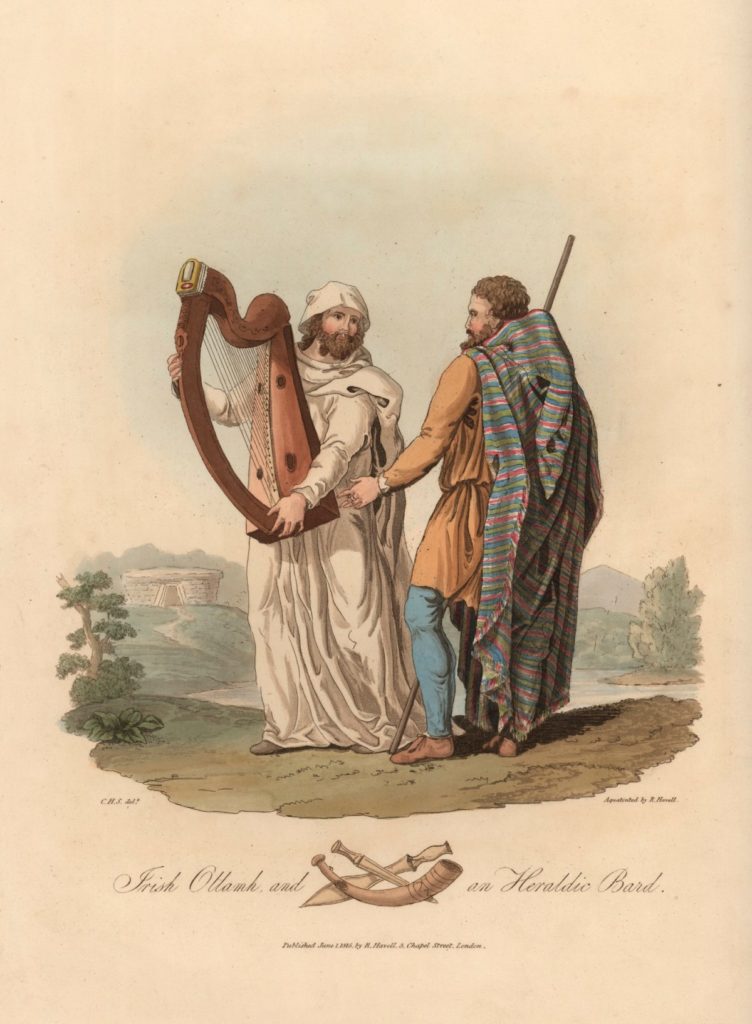
This history is so widely attested that it must be taken as an unquestionable fact, because it is recorded by all Historians of the Celtic race. The many stories of their sagas and exploits are told throughout all early Irish literature for they were its creators.
It is from these words that we learn long before the Christian era, the Ollam of the Irish and Scottish nations were some of the most powerful people who ruled from the Hills of Tara for well over 1500 years or more. Their legal counsels and judges could issue edicts that could make or dethrone a king in a day and thus were endowed with a distinction equal to that of the king.
The Supreme Ollam sat next to the king at the table where he was privileged to wear the same number of colors in his clothes as the king and queen, while all other ranks whether warriors or fellow Ollam had fewer colors. You will find that from the most remote periods of early history in the Irish annals to modern times that we can trace a succession of the Ollam who were honored on a level of noble kings and warriors.
Today we see this tradition of colors identifying rank carried on mainly in Catholicism and the military. Also, to this day in Ireland, an ollam or ollamh means as it did then “a doctor, professor and or scholar of any kind of learning.” In other countries around the globe such as in the Islamic countries, these learned me are known as the Ulam of Mulah.
The Ollams power was derived from their extensive knowledge that in ancient times past was always hereditarily passed down to them which included all types of sciences, literature, religion, history, laws, heraldry, genealogy, logic, reasoning and even magic, to name a few. Their schools became the most celebrated in the Western world under the name of Mur-ollam-hara (MurOllam-han), meaning the “College of the Learned or the College of Doctors.” (Four Masters, p. 293. – vide O Halloran, Book iv., chap. 1, p. 132).
Like their Eastern Ulam ancestors, the professions of the Irish Ollam, whether it be poetry, art, history, building, law and even propaganda, had invariably run in families, so that members of the same household often devoted themselves for many generations to their particular craft.
I believe it was from thousands of years of training and specializations passed down in families that today we see many gifted people who seem born to do specific jobs whether they are world-class scientists, religious scholars, builders, lawyers, judges, poets, singers, and leaders, to name a few.
These various classes of Ollams had produced people who were specialized in their trades and were thus segmented and paid on these abilities. For example, the Book of Rights states that a king kept in his household an Ollam of each profession, who was well paid for his services. The literary Ollam from forbidden from sharing his work with the lower class people and only with kings and chiefs and with their guests.
For the meaning of the word, nobility is “able to know.”
Poets were charged with entertaining the lower grades to attend a lower class of people. The prices for the compositions of the several grades of poets may be seen in the “Small Primer,” Br. Laws, v., pp. 57-71.
A an Ollam “He was also supposed to know the prerogatives, rights, duties, restrictions, tributes, of the king of Ireland, and of the provincial kings and the poet or the learned “historian” who does not “know the prerogatives and the prohibitions of these “kings is not entitled to visitation or to sale” [of his compositions].
It was also said that the Ollam was expected, if asked, to repeat the whole statement from memory, “so that he can recite them all at each noble meeting.”t As a learned man he was expected to answer reasonable questions, and explain difficulties;
“He is great to expound, and he expounds and solves questions”—says Cormac’s Glossary (127, “Ollamh”).
SONS OF THE IRISH OLAM
In the ancient mythologies of Ireland listing “the most famous and noble persons of the Tuatha De Danann,” we find “the six sons of Delbaeth, of Ogma, namely, Fiacadh, Ollamh, Indaei, Brian, Iuchar, and Iucharba.”
The Pictish Chronicles more accurately listing the genealogies which can coincide with science informs us that they were from Ollamhan, from whence comes Mur Ollamhan at Tara or Teamhair (Hill of Tara), to Fiacha, son of Baedan, who fettered the hostages of Erin and Alban.
It was from the Clan Baedan (Son of Dan) who became the de facto father of the senior line of the Hy-Niall kings (King of Ireland and Scotland) because he was the great-grandson of Niall of the Hostages and his grandmother was Scottish Princess of Dalriada named Erca which united the two ancient kingdoms of Scotland and Ireland into one.
We learn that from him the feast of Teamhair (Hill of Tara) was first instituted at Mur Ollamhan. Then, after naming his six successors, the legend adds, “These then are the seven kings that ruled over Erin of the Cruithnigh of Alban.”
You will find these same seven kings are also placed on a list of the mythic pagan kings of Ireland with the first being Olam Fodla is described as “a prince of the most comprehensive knowledge, that ever sat on the Irish Throne is credited with erasing all falsehoods—and he punished severely all historians who made improper representations” (Keating, vol. 1, p. 197).
Ollamh Fodla who is also attributed to one of the most important tasks which is the tribal organization of his people; for according to the Annals of the Four Masters, ‘it was he also that appointed a Toisech over every Triocha Ceud or barony, and a Bruighigh over every Baile or township, who were all to serve the king of Erin.”
It was from these ancient clans of Ireland where we find the professions of some of the most famous Ollams in history who were instructed to teach their own children, and kinsmen, to always be their successors and then with the advent of the New Testament (New Law) for the global Gentiles – they were instructed as it were to “Go ye and teach all nations.”
It was from these families and the schools of the Olam in Ireland which gave rise to some of the most famous Saints of the early Church such as Saints Columba and Patrick whose disciples became masters in the Christian religion. Their Great Work for bringing law, order and learning around the globe to their English, German, and French Brethren that in the years following their deaths, Ireland was termed Sanctorum Patria, or the Saints’ Country.
Author Charles O’Connor, eloquently explains their missionary efforts in his “Dissertation on the History of Ireland,”:
“The monks set up schools, in which they educated the youth, not only of the island but of the neighboring nations. They sent their missionaries in shoals into the continent, converting its heathen and confirming its Christian inhabitants; set up schools in those parts; and laid the foundations of the most flourishing universities in Europe.
They taught the Saxons and Normans the use of letters, and they converted the Cruthneans or Picts to Christianity by the preaching of Columbkille, who quitted his right of succession to the throne of Ireland, to reign over the hearts of a foreign people, enemies to his own nation.”
This family line had produced several of the most well known Gnostic luminaries in the early Celtic Church. In the course of history, that had gone by the name of Baedan or Baithen, son of Brendan, and were the legal successors of Saint Columba as Abbot of Iona.
It was at this time that Saint Columba had declared “Power by Baedan of the yellow hair will be borne from Ireland on him [the steed].”
0 God, wilt thou not drive off the fog, which envelopes our number,
The host which has deprived us of our livelihood,
The host which proceeds around the cams’!
He is a son of storm who betrays us.
My Druid,—he will not refuse me,—is the Son of God, and may he side with me;
How grandly he bears his course, the steed of Baedan” before the host;
Power by Baedan of the yellow hair will be borne from Ireland on him [the steed].
So we know that Baedan who was Monarch of Ireland jointly with his nephew, Eochaidh, in the year 566 after he became the immediate successor of Saint Columba in the 6th century.
It is said that he ruled Iona for only three years, but had left his 12 sons to take his place upon his death in which the Irish Annals record the death of Baedan MacCoirill, King of Ulster, and a naval expedition in the year 598. St. Adamnan, in recording the death of St. Columba, tells us that the dying words of the Apostle of Iona, as he was transcribing Psalm 53, were: “I must stop here, let Baithéne write what follows”.
Baithéne had been looked on as the most likely successor of St. Columba, and so it happened that on the death of that great apostle, in 596, the monks unanimously confirmed the choice of their founder. Baithéne was in high esteem as a wise counselor, and his advice was sought by many Irish saints, including Saint Fintan Munnu ofTaghmon. Abbey St Bathans in Berwickshire (southeast Scotland) may be named after him.
Here is a shortlist of some of the Saints of Iona from the House of Baedan (Baothin) who took the name of Beadan (Baothin):
* Baedan, son of Muircheartach, joint-king of Ireland, 555, 562, 563.
* Baedan, son of Ninnidh, son of Fearghus Ceannf hoda, slain, 567.
* Baothin – Son of Brendan and the founder of the House of Baedan. – He was also known by the various spellings such as Baedan, Buadan, Baithen called Baitan Mor. He was the legal successor of Saint Columba, died, 595.
* Baedan Mac-Ua-Cormaic, abbot of Cluain-micNois, died, 663.
* Baedan, abbot of Beannchair, died, 665.
* Baedan, bishop of Inis-Bo-finne, died, 711.
* Baedan, of Cluain-tuaisceirt, died, 804.
* Baedan, abbot of Birra, died, 926.
It was from the family of Badan that naturally produced several generations of learned and professional men known as the Ollam who were on a level, and social rank, with the chieftain grades. From this clan, I believe that there would be numerous other families who were either cousins or allies who would be given royal titles for their Great Work.
I believe that many of these Ollam clans would be legally signified by simply adding an O’ to the beginning of their names which is something we see only used in ancient Ireland and also the appeleation of Mac would be used meaning “Great of Chief” for the “Chieftan” families of the Ollams.
Ollam Clans who were the most distinguished amongst the professor castes are listed in The History of Ireland from the Earliest Period by Geoffrey Keating who had written;
“The most distinguished amongst the professor castes were, in Ulster, the O’Cleries, O’Gnives, the O’Slevins, O’Husseys, O’Donnellies, O’Dalies, O’Mulligans, O’Farrellies and O’Curneens; in Connaught and Meath, the O’Maelconaries, Mulconries, or Conries, the MacFirbisses, the O’Duigenans, the O’Dugans, the O’Higgins, and O’Coffees.
The O’Dunns and MacKeoghs, were the chief bards of Leinster; the MacGraths, the O’Dineens, the MacBruodins or Brodies, the MacCurtins, and MacGowans, and some of the O’Keefes, in Munster. The O’Dalies were found distinguished as poets in all parts of Ireland.
“In music the ancient Irish were highly celebrated. It is stated in the Chronicle of IIanmer, p. 197, that in the latter end of the eleventh century, about A. D 1098, Griffith ap Conan, Prince of Wales, who had resided a long time in Ireland, brought over with him, to Wales, “divers cunning musicians, who devised in manner all the instrumental music upon the harp and crowth that is there used, and made laws of minstrelsy to retain the musicians in due order.’
Thus it appears that the famous Welsh bards were indebted for their knowledge of the harp chiefly to the Irish. The Irish in former ages were the most famous harpers in Europe, and continued eminent in the art down to modern times.” Turlough O’Carrolan, our last very eminent harper and composer, died in the year 1738.”
There were various specialties and names for the professions of the Ollam. For example, a Doctor of Law was called “Ollamh re Dighe” (dlee); a Doctor of History was styled “Ollamh ré Senchas” and a Ollamh releighes” (ollave re lyas) meant medical doctor. (The History of Ireland from the Earliest Period to the English Invasion By Geoffrey Keating)
Some of the most eminent of Ollam would become tutors to kings and also be the founders of various Mur-ollam-hara (MurOllam-han) schools around the world in which they set up a barony, and a bruighean (brugh, brughaidh, breean or breen) over every Baile or township from which they had settled.
This old Irish word bruighean (bru, brugh, brughaidh, breeoge, breean or breen) appears to mean “royal house or royal mansion” and was used to signify the royal house and place of their barony (barune) or government.
This word Bruighean occurs in the Feast of Dunnangedh in relation to pillars and the old Tribes “that his progeny should still have the legitimate possession of Tara with its supporting families, and the old Tribes of Meath perpetually and forever.”
We find several place names for various Irish townlands located in Antrim, Donegal, Tyrone, Limerick, and in Tipperary. For example, the town Breenaun in the parish of Ross, Galway; and Breenagh in the parish of Conwal, Donegal, and Breeoge, in the parish of Kilmacowen—Bruigheog.
THE IRISH SONS OF OLAM ATTACKED FOR THEIR GNOSIS
In Moore’s History of Ireland, we learn that in the year 812, the Danes burned the abbey of Derry, and massacred the clergy and students and their schools and sacred edifices of Armagh were burned in the ninth century, but the disaster was soon overcome.”
Eminent scholars from abroad are found visiting Armagh in the next century, and during the interval of its misfortunes education throve at Clonmacnois, Devenish, and Kildare. The annals of Munster record that, in the year 812, the Danes burned the abbey of Derry, and massacred the clergy and students. Probus, author of a life of St. Patrick, in two books, was chief lecturer of the school of Slane, and met his death during an attack made by the Danes upon the church, in the year 950. Clonmacnois was cruelly pillaged in its turn.
So many eminent Irish Olmam had made such an impact on Continental European royal courts and had gone on to become Catholic Bishops that they excited the jealousy of other scholars in various countries.
In the tenth century, the Irish Olman were denounced by their competitors who launched an ad hominem attacks calling them the “Episcopi Vagantes” and making jealous decrees of different councils such as in Calcuith that went so far as to declare that no Irishmen should be admitted to clerical functions—“et Scoti non admittentur sacra ministrare.”
CONCLUSION
Since the most ancient times, it has been a policy of kings to recognize and promote thier tutors as the most learned men of their kingdoms by bestowing upon them royal dignities of honor and trust in their court.
For example, we find this tradition in Ancient Greece when in 343 B.C., King Philip II hired the philosopher Aristotle to tutor Alexander the Great philosophy, poetry, drama, science, and politics over the course of only three years. We find this also in the Old Celtic storied like in the relationship between King Arthur and his tutor Merlin.
The general tendency to honor the Ollam in history I believe stems from the fact that without their Great Work, most of history and the eternal wisdom would be lost. For we know the kings managed the kingdom while the warrirors defended it and the Ollam were in charge of all knowledge and controlling it as well for it is well known that “knowledge equates to power.”
The Irish Helicon records the legends of the royal road to the Ollams great Gnostic learning.
We learn that King Cormac Mac Art was wandering through Tir (Tyre) Tairngire or Fairyland, when he saw beside the rampart of a royal dun or palace a shining fountain with five streams issuing from it, making a murmur more melodious than any mortal music.
There were five salmon (s-olman) swimming about in the well: and on the margin grew nine hazels which often dropped purple (Phoenician) nuts into the water. The moment a nut fell, one of the salmon caught it, and rejecting the husk, ate the kernel.
As Cormac looked on, he saw many people coming to the well in turn and drinking. And when he inquired the meaning of these strange sights, he was told that this was the “Fountain of Knowledge (Gnosis)”; that the five streams were the five senses, through which knowledge is obtained; and that those who drank were at once endowed with great knowledge, so that they were thenceforward called;
“People of many arts and sciences” {Lucht na n-ilda1i).”
Moe is the founder of GnosticWarrior.com. He is a father, husband, author, martial arts black belt, and an expert in Gnosticism, the occult, and esotericism.
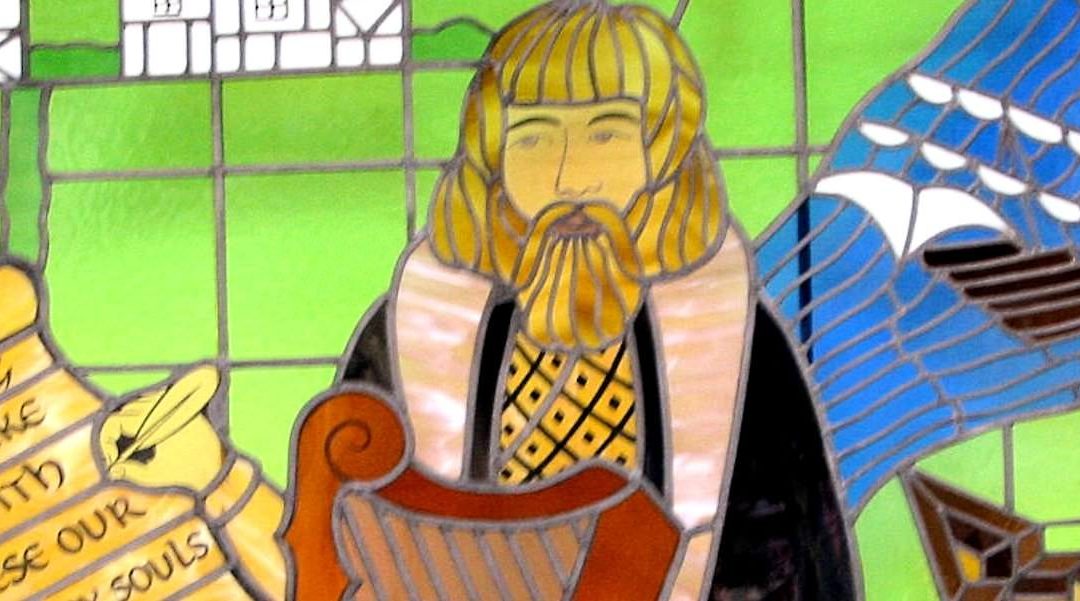
by Moe | Oct 7, 2019 | History of the Brotherhood, Irish History, Latest Media
“The native rulers fled abroad in the episode known as the Flight of the Earls but, as with all the major Irish kingships, the line of descent continues into the present day.”
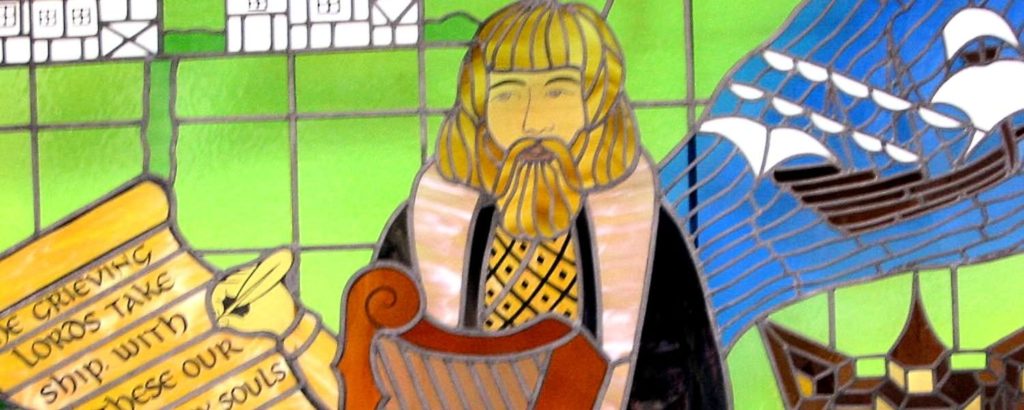
One of the oldest and most important kingdoms of Ancient Europe had originated in the Northern lands of Gaelic Ireland in a place that I would like to call the “New Tyre of the West.” It is from here where we can find the lost Tribe of Dan who is called in the Ancient Irish Annals the “Tuatha-da-Danaans.”
A tribe, people, and place who I believe along with the Tribe of Judah that one day may be credited with helping lay the cornerstone down for the foundation of Ireland and many other countries which spawned shortly thereafter.
The lost history of the Irish Tyranians who I believe is connected to the Biblical “Tribe of Dan” can be found secretly encoded into their long illustrious history, the geography of the region, and the hardships and success they have both endured and earned through countless centuries of fighting for God’s kingdom.
Today, we know of this location of the Irish Tyranians with their tribe the Tuatha-da-Danans in the province of Tyrconnell, also spelled Tirconnell, in the present-day County Donegal. Anciently, I have found that it was also spelled Tyr II, Tyrol, and or Tyrone.
ETYMOLOGY OF TYR-CONN-ELL
Before I delve into this fascinating history, it is important that I first quickly explain the etymology of the name Tyrconnell and also the County Donegal.
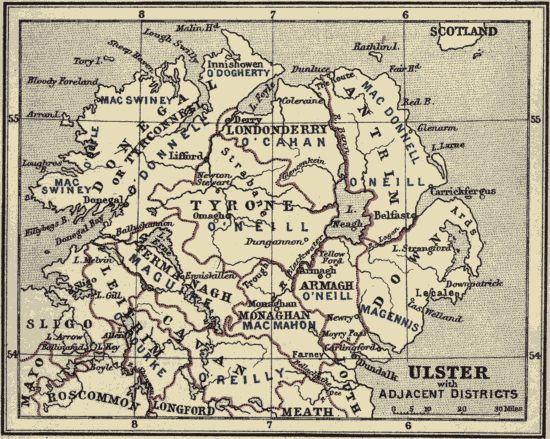
Tyrconnell is a compound word containing the words “Tyr, conn, and ell.”
In a previous article, Tyre-Egypt: God’s Ancient Stone Masons of the Tora, I had went over the etymology of Tyre where I show that it is derived for the old words in many different languages for rock, stone, and or mountain which was anciently called “Tur, Tsur, Tzor, Tor, Tora, Toorah, Tura, Tyr, Tir etc.”
I had also shown that the Phoenician Tyranians were world-traveling Master Masons who were the hereditary descendants of King Hiram in search of the Tyr Limestone. They were also world-famous throughout history to be the best shipbuilders, navigators, and businessmen who had a long tradition of naming their new settlements in a new language that can be proved had spawned from their Phoenician ports and alphabets which they took with them from the East.
After careful analyzation of their history, this proves to me that this was their simple secret formula for not only the birth of successful nation-states but also the legal identification of their landholdings ie: real estate titles.
They seem to follow the same exact Babylonian plan wherever they would venture around the globe as we find in Northern Ireland such as in Donegal County and Ulster where they governed. I would assume that if you are an ancient military and city planner for Tyre that they would both incorporate and honor the necessary ingredients for city planning from their ancestors which included cornerstones brought from their ancestral lands, language, names, laws, religion, and their main method of domination, commerce.
Their main military goal where they traveled was to find and seize all territory along a country’s largest waterways, rivers, and lakes for unlimited freshwater, agriculture and also the safest seaport for travel, commerce, exports, and imports.
In this areal photo of Northern Ireland, we can clearly see that any tribe that ruled from Donegal and Ulster controlled the largest waterways, ports, and from North Coast, they could easily deploy to Scotland and rule these lands with their boats and armies.
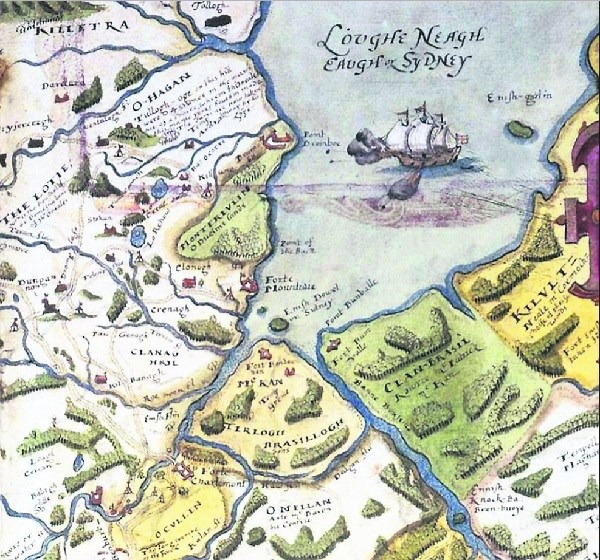
Not surprisingly, it was in these precise locations where they would not only find their prized white limestone (AKA – Tyr, Tir, Tur, Tor) for their immortal Masonic endeavors, but they would also be able to gain control of entire countries and sometimes multiple countries. Once they would become established, they would rule these lands through commerce, laws, religion, myths, and education which they created this system of conquering a native people’s mind, body, and soul which all coincide with one another.
Hence, what worked in Tyre, Egypt and even better in Tyre, Crete would also work wherever they would travel such as this new successful colony in what could be called the third Tyre – Tyrconnell, Ireland. They would also use place names to designate their specific domain (dan-ain), a compound word derived from dan-ain for the Tribe of Dan
This same military methodology that endures the test of time to this very day.
The meaning of the next word in Tyr-conn-ell is ‘conn or con’ which means ‘with’ and is related to the Gaelic ‘comh’ – a prefix denoting “with, com or con.”
Not surprisingly and as I have witnessed as a global fact, these Irish Masonic Builders of Solomon’s Temple from ancient Tyre had added the old name for God onto their name which is the Phoenician and Hebrew El also spelled ul,il, or al and can be variously translated as “God, Lord and or Governor”
With that said, the meaning of Tyrconnell is “Stone-Rock of God or “God’s Stone Masons.”
ETYMOLOGY OF DONEGAL COUNTY
As I mentioned above, the men of Tyre had honored their ancestor’s several ways and I have found that the main method by which they did so was the naming of geographic locations that they controlled like the city of Tyrconnell in their county which they named ‘Donegal.’
In this compound word of Donegal which is composed of the words “don or dan” and the word egal”, we can find the name of the lost Tribe of Dan who is called the “Tuatha-da-Danans” officially encoded into North Irelands ancient history.
The meaning of the Gaelic name Don is also Dan in English was applied to their territory Donegal in order to honor their Tribe of Dan. Since ancient times, the name Dan, Don and or Dom was a title of respect given in Ireland, Scotland, and England to learned or clever men.
For example, in the Lowland Scotch language, a Dominie was a “schoolmaster” and in Latin, a Dominus is a lord, a master and where we get the word dominate, to rule, and dominion, lordship, mastery, rule. Likewise, in Spanish, a Don is a title that is equivalent to “Sir or Master.”
This was the same title of Dom for the original Catholic Benedictine Priesthood which was first only applied to monks, but afterward was extended to persons of all respectable professions.
The next word in Donegal is ‘egal’ which simply means “equal or equal to”.
Therefore, we can say that the territory of Danites was the County Donegal which means the “County or Province Equal to Dan.” I believe this could be in reference to the “Western Branch” in which they being now masters of both Ireland and Scotland were equal in the West to their Eastern Brethren of the Tribe of Dan.
GEOGRAPHICAL SCIENCE SETS THEE WAYMARKS OF DAN
We find that the Tribe of Dan has Set thee waymarks in the places which were named after them meaning Dan’s resting place. This geography corresponds to ancient Irish history which says that in approximately 585, B. C, a ship landed at Ulster, Ireland, which was manned by the “Tuatha-da-Danans” (Tribe of Dan).
According to the annals, amongst their cargo on their voyage to Ireland they were in possession of a large oblong stone in which after their vessel had been temporarily disabled on the coast of Spain, during which the King of Spain attempted to obtain possession of the stone, but the king failed and the guardians of the stone, the Tuatha-da-Danans made it out of Spain to land on the beautiful coast of Northern Ireland.
In Ptolemy’s map of Ireland, we find Dan’s- Lough, Dan-Sowar, Dan-Sobairse, Dan’s resting place, and Dan’s habitation, and Dan-gan Castle (the birth-place of the Duke of Wellington).
Irish Historian, Thomas Moore had written that the Tuatha de Danaan (Tribe of Dana), “after sojourning for some time in Greece… proceeded from thence to Denmark and Norway”.
Author Geoffrey Keating (ca.1570 1646)had said that the Danaans were a people of great learning and wealth; they left Greece after a battle with the Assyrians and went to Ireland; and also to Danmark, and called it “DAN-mares”, “Dan’s country.”
According to The Essential Teachings of Herbert W. Armstrong, the Tribe of Dan left their serpent waymarks at “Danslaugh,” “Dansower,” “Dundalke,” “Dundrum,” “Donegal Bay,” “Donegal City,” “Dunglow,” “Londonderry,” and ” Dingle,”
THE IRISH OLLAMS SAME AS SONS OF ULAM ALL OVER THE WORLD
It was said in the Irish Annals that among the passengers of the Danans was a princess of remarkable beauty named Tephi who was accompanied by her guardian, afterward known by the name Ollam Fola. In my previous article, I explain that King Ollamh (Ollam) Fodhla was known as the great lawgiver and patron of learning to early Ireland.
To this day in Ireland as it did then, an ollam or ollamh means “a doctor, professor and or scholar of any kind of learning.” In other countries around the world such as in the Islamic nation, these learned me are known as the Ulam of Mulah.
King Ollam is mentioned in the “Annals of the Four Masters,” p. 412, as a sage and law-giver. He was said to have founded a College of Ollams at Tara, or a ‘School of the Prophets.” There was actually a famous college at Tara called the Mur Ollam han, or the House of the Learned. Four Masters, p. 293.
“Besides all these reforms the great legislator founded a University at Tara, which, for rank and dignity, preceded all others of the kingdom, and which he called MurOllam-han, or the College of Doctors (vide O Halloran, Book iv., chap. 1, p. 132), which, since we have discovered the word to mean “Revealers,” would stand for the School of Revealers.
Ollam Fola ordered the sacred records to be kept at Tara. “These form the basis of ancient Irish history.” (Annals of the Four Masters, note p. 297.) Ollam Fola was called the “Chroni. cle’” (vide Moore, i, 114.)
The name we find in Ancient Irish history as Ollamh (Ollam) we can also connect Biblically to the Sons of Ulam who Bedan, meaning Son of Dan can also align to ancient Irish history.
Another passenger on the boat mentioned in the Irish annals that were associated with Tuatha-da-Danans was a man named Simon Baruch who we can identify as part of the global Sons of Ulam or in Gaelic – Ollamh (Ollam) who have been tasked to bring this knowledge to the world.
This man Simon I will discuss in a future article in which I will detail the fascinating history of the Irish Sons of Ulam of whom I believe one of the most famous is Saint Columba or Co-ulum-ba who was once a Supreme Ulam of Ireland.
THE TYRE MASONS OF TARA IRELAND
We learn that from Irish mythology that when the Tuatha-da-Danans landed in Ireland, they were newcomers and there was already a ruling king whose castle in Meath, was changed from Lothair Grofinn to Tara.
It is said that Princess Tephi upon her death was buried here in a sepulcher that is covered by a mound of earth 60 feet square whose remains are intact to this day and is called “Tara or The Hill of Tara.”
The Hill of Tara is an ancient ceremonial and burial site near Skryne in County Meath, Ireland. According to ancient tradition, it was the inauguration place and seat of the High Kings of Ireland.
Here is an ancient depiction of the topography of this area.
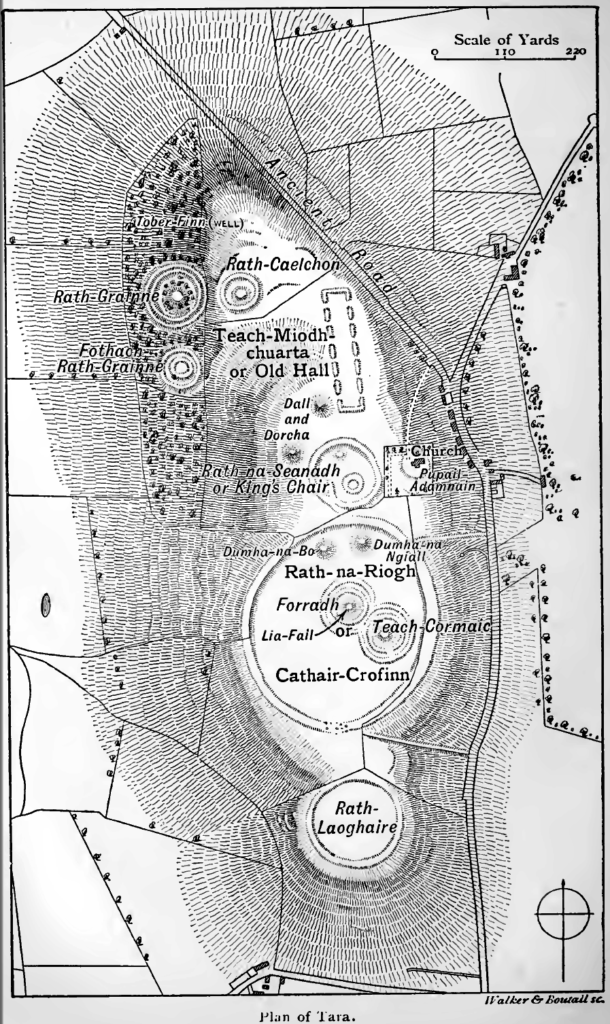
It is here in Tara, where you will discover the ancient remnants of the Masons of the Tyranian Irish who left numerous limestone monuments and earthworks — including burial mounds, round enclosures, the “Mound of the Hostages”, and a standing stone that some believe to be the “Stone of Destiny” (Lia Fáil).
There is also a church and graveyard on the hill.
Modern-day Tara is part of a larger ancient landscape and Tara itself is a protected national monument under the care of The Office of Public Works, an agency of the Irish Government.
To reiterate from past research, the name Tara comes from the words “tor, tur, tyr, tir, tora, torah, tura etc.” which all mean “stone or rock and later also to mean “mountain, chief, Lord, God, and or prince for their descendants.”
I believe these precise locations were known well over 2,000 years ago and were shown on Ptolemy’s ancient map of Ireland.
In Isa. 66-19 we read, and I will set a sign among them, and I will send those that escaped of them unto the nations, etc., to Tarshish and the Isles afar off. On an Ancient map of Ptolemy’s, England and Scotland are named Javan, and Spain, Portugal, and France are frequently mentioned as Tarshish, the ships of Tarshish, etc.
Ulam’s son, Bedan whose history and name we can bridge with the Tuatha-da-Danans and their Irish High King Baedan which means “Son of Dan” (King Tech- Baoithin, Baithen, Baithin, Baithan, Baetin, Baitan Mor, Báetán mac Muirchertaig, “Baithen the Great”.)
This King Baedan became the father of the senior line of the Hy-Niall kings (King of Ireland and Scotland) because he was the great-grandson of Niall of the Hostages and his grandmother was Scottish Princess of Dalriada named Erca which united the two ancient kingdoms of Scotland and Ireland into one.
The Pictish Chronicles informs us that they were from Ollamhan, whence comes Mur Ollamhan at Tara, to Fiacha, son of Baedan,” who fettered the hostages of Erin and Alba. Also, seven kings of the Alban Cruithnech governed Erin (Ireland and Scotland) at Tara.
For example, Of this king’s descendants, we see the name Olma encoded into their sirnames such as his son Colmán Rímid and Maeluma.
KING MILESIUS OF IRELAND THE SAME AS KING MILESIUS OF CRETE
As I mentioned above, in the tradition of honoring their mariner ancestors, they would rename these new lands they had conquered and even the characters in their myths and also importing the very language, laws, and history in the very boats that carried them.
This is where we meet with more of their ancient mythology encoded into the Irish Annals, which include volumes called the Annals of Ulster, the Annals of the Four Masters, etc.
A major clue to the original homeland of these people comes from the old Irish folklore which states that they arrived in Ireland with an expeditionary force from anywhere between the 17th to the 6th centuries B.C. They are said to have spawned from the fifth son of King Milesius who was the progenitor of the Milesian race and hereditary Father to some of the earliest tribes of Ireland and the noble families of Ulster.
This story of King Milesius in Ireland coincides exactly with the mythology of their homeland which I believe was both in old Tyre (Tora, Tura) Egypt and in new Tyre on the Holy Island of Crete.
The ancient homelands of their ancestors.
In researching the most remote mythology on this King Milesius, we will discover that the oldest reference takes us directly to the ancient mythology of Crete where we find it was King Melissus who first introduced sacrifice to the Gods, and introduced new rights and sacred ceremonies on this island.
He had two daughters Amalthea and Melissa, which nursed the child Jupiter, and fed him with goat’s milk and honey. Melisseus was the eldest and leader of the nine Curetes (Kuretes) of Crete. The meaning of the name Melisseus is “bee-man,”and another form of Melissus, in Cretan means, “honey-man.”
CURETES & CABIRI OF CRETE SAME AS CABIRI & DRUIDS OF IRELAND
According to Diodorus Siculus, the Curetes lived in the time of Rhea; The Father of History, Herodotus and Strabo writing later both had said that the Curetes were originally Phoenicians who accompanied Cadmus out of Phoenicia.
The ancient Curetes (Kuretes) of Crete I have written extensively about these various connections in history with the Priesthood of Zeus who were also known by many other names such as the Telchnines (Telknines, Telkhis, Telegonus, or Greek, Τελχῖνες), Corybantes, Dactyls, and Cabiri.
These same Priesthoods with their same history and myths bring us to another connection to Ancient Ireland that would be hard to refute which is through the history of a well-known but mysterious Priesthood called the Druids.
For example, both the Cretans and Egyptians had a priesthood that was called the Cabiri and so did the ancient Irish.
In a previous article, The Irish Druid Cabiri Are the Same As the Phoenician Cabiri, I explained that you will find that the Latin name Cabiri and Old Irish Cabur is derived from the Phoenician Hebrew word Kabir that is sometimes spelled Cabir, Chabir, Chabiru, and Chabireh. Cabur was once of the ancient God of Ireland being that of the ancient Irish pantheon of Gods known as Axire, Axcearas, Coismaol, and Cabur.
The priests of this God were called the Druid Caburi or Cabiri.
According to the ancient Phoenician historian, Sanchoniatho, the mysteries of the Cabiri were first celebrated by the Phoenicians, and introduced into Greece. He had written that first or original Cabiri were the eight Sons of Sydyc, who was a Canaanite.
They lived in the Days of Taaut of Thoth who is the same as the Phoenician Hermes. Pausanias, the Greek historian and geographer who lived in the time of his cousin, the Roman Emperor Hadrian, relates, that the Mother of the Gods was anciently worshiped at Thebes with the Cabiri, whose Names and Mysteries he durst not divulge.
THE FALL OF THE IRISH TYRE
The kingdom of Tyrconnell represented the core homeland of the Tribe of Dan who became known in the Irish Annals as the Tuatha-da-Danans with various families and subunits of families whose the most successful under the banners of the Ulaid, Northern Uí Néill, Niall of the Nine Hostages, and Ulster all vying for power.
The chief seat of the ancient royal Irish families was sacked and ceased several times by English forces in their attempts to reduce the country to obedience to the royal authority. However, the warrior spirit of the Irish branches of the Tuatha-da-Danans proved to be a formidable fight to the invading English until the close of the reign of Elizabeth, when it would become the location of fighting during what was called Tyrone’s Rebellion at the end of the 15th Century.
It was said to be burned by Hugh O’Neill, earl of Tyrone, to prevent its falling into the hands of the queen’s forces in Ireland.
Their power continued to exist until the 17th century when before the English invaded their lands, the ancient native rulers of Ireland fled to the North and abroad in the episode known as the Flight of the Earls. It was then finally incorporated into the English-ruled Kingdom of Ireland.
But, as with all the major Irish kingships, the line of hereditary descent continues into the present day.
LEGAL BANNERS FOR THE WARRIORS OF GOD AND THE KING
In researching the Ancient History of Ireland, you will find that it was here that the first laws and legal system of the Western World was developed in the reign of Ollamh Fodhla who I have mentioned were the learned men who ruled over their people. This legal system was known as the Brehon Law which operated late into the 17th century and was abolished and later became the English common law system. After the English had conquered these lands in the time of Elizabeth I, the Brehon laws were considered to be old, lewd, and unreasonable.
However, one of the most important legal ordinances of Brehon Law was for Tribal Heraldry where their tribal insignias bearing various symbols and colors would identify their rank. It is my understanding that before this time in the West, tribal and royal heraldry was not governed by a legal assembly such as the Ollamh Fodhla.
The various Celtic Tribes who jostled for control of Ireland were distinguished by particular symbols and colors each class of society was to wear in their clothes were specially regulated by Brehon Law.
Servants wore clothes with one color and one step up was a rent-paying farmer who wore two colors. Military officers wore three colors and their chiefs wore five colors. The highest members of society being the ollamhs and poets wore six colors in the clothes and seven colors in the clothes of kings and queens.
This system of royal authority was left to the family and tribe to be in charge of their own heraldry and royal rankings which would leave this legal loophole open to corruption and fraud. In researching the royal families of the world and priesthood over the last 2,500 years, I would say with confidence that this fraud has most likely happened quite often. Especially under the English Common Law System.
The Rev. Geoffrey Keating, in his “General History of Ireland,” explains that in the reign of Ollamh Fodhla, in a “great triennial assembly at Tara, it was ordained by a law that every nobleman and great officer should, by the learned heralds, have a particular coat-of-arms assigned to him according to his merit and his quality, whereby he should be distinguished from others of the same rank, and be known wherever he appeared.”
An ancient historical account of the battle of “Magh Rath,” that was compiled from ancient manuscripts of Finn Mac Gorman, Bishop of Kildare and later transcribed by John O’Donovan from the Book of Leinster shows us exactly the names, symbols, and colors of some of these families.
Finn Mac Gorman was Bishop of Kildare in the first half of the twelfth century and died in the year 1160. Here is Mac Gorman account of the various Tribal Banners which was published in 1842 by the Irish Archaeological Society (p. 227, see also p. 847):—
“Mightily advance the battalions of Congal
To us over the ford of Ornamh;
When they came to the contest of the men
They require not to be harangued.
The token of the great warrior of Macha—
Variegated satin on warlike poles;
The banner of each bright king with prosperity
Over his own head conspicuously displayed.
The banner of Scannlan—an ornament with prosperity,
And of Fiachna Mor, the son of Baedan,
Great symbol of plunder floating from its staff
Is over the head of Congal advancing towards us.
A yellow Lion on green satin,
The insignia of the Craebh Ruadh,
Such as the noble Conchobar bore,
Is now held up by Congal.
The standards of the sons of Eochaidh
In front of the embattled hosts,
Are dun-coloured standards like fire.
Over the well-shaped spear-handles of Crumthann.
The standard of the vigorous king of Britain,
Conan Rod, the royal soldier,
Streaked satin, blue and white,
In folds displayed.”
IRISH TYRE AND THE TRIBE OF DAN FROM IRELAND CONCLUSION
To some people of modernity, this history seems nothing but a mythological fairytale and or legend of days gone by. But to others like me, it is a beautiful homage to the true history of our people and the world in this 6th Age encoded into our Holy Scriptures, nation myths and the laws of our lands of which we are in the year 2019.
The facts of hiostory are well known that the Irish tradition tells us that they are a fighting race, and as it were, “mariners” (Ezek. xxvii. 8) or seafaring men. They have hung their shields on the walls of Tyre (Ezek. xxvii. 10), and being insular, they have been vindicated by true history and their character as the Warriors for God via the Tribe of Dan.
Let it be said that legend informs us that the Tribe of Dan had also brought with them the famous Stone of Destiny, and is also known as the Stone of Scone and The Coronation Stone (Liagh Fail) on which all succeeding kings of that race were crowned. It was used for centuries in the coronation of the monarchs of Scotland, and later the monarchs of England and the Kingdom of Great Britain.
Historically, the artifact was kept at the now-ruined Scone Abbey in Scone, near Perth, Scotland. It is also known as Jacob’s Pillow Stone and the Tanist Stone, and in Scottish Gaelic, clach-na-cinneamhain.
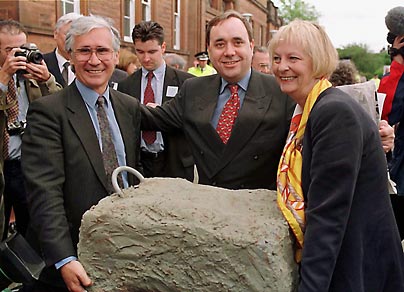
Fergus the Great borrowed the Liagh Fail to be crowned on, after his invasion of North Britain; and, being deposited in the abbey of Scone, it continued there until the reign of Edward I., who had it conveyed to Westminster Abbey, where it is now placed beneath the inauguration chair, having its name changed for that of ‘Jacob’s stone.’
Its value appears to rest upon the destiny contained in a very ancient Scythian or Irish verse, the purport of which is, ‘that where the Stone of Destiny is preserved, there a prince of the Irish race should govern.’
Moe is the founder of GnosticWarrior.com. He is a father, husband, author, martial arts black belt, and an expert in Gnosticism, the occult, and esotericism.










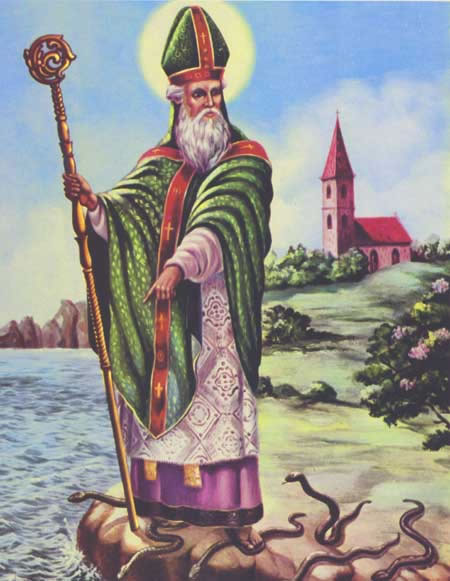
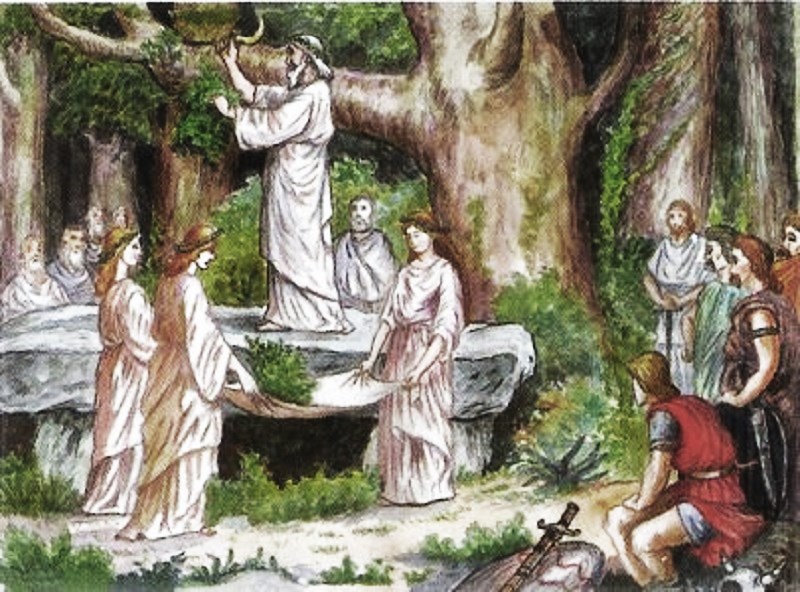
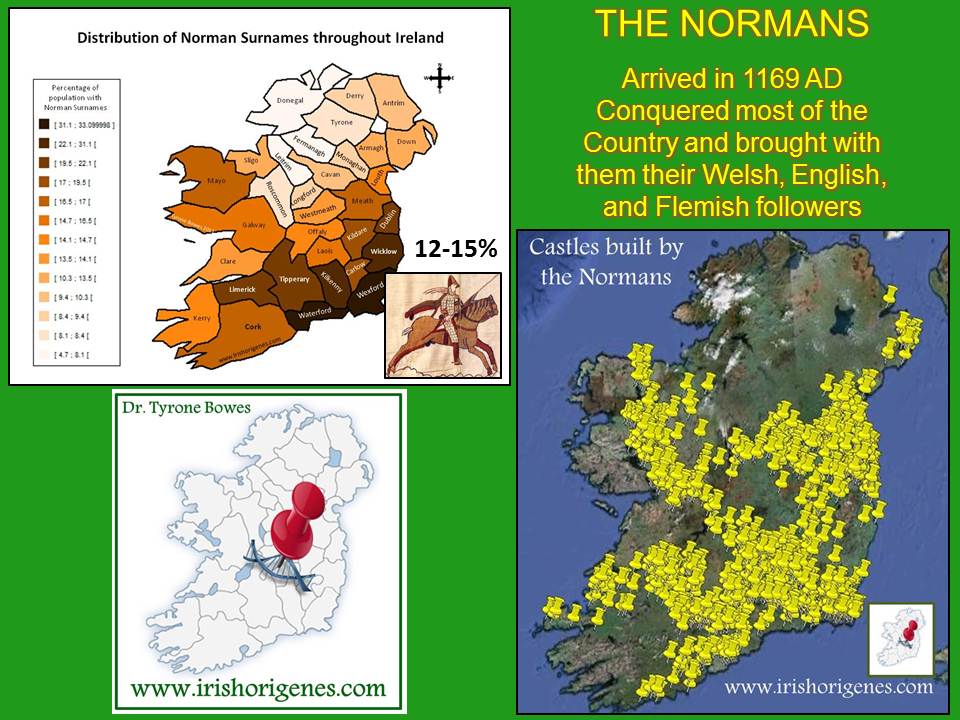 as the genetic features of brown hair and blue eyes, scientists have discovered.
as the genetic features of brown hair and blue eyes, scientists have discovered.